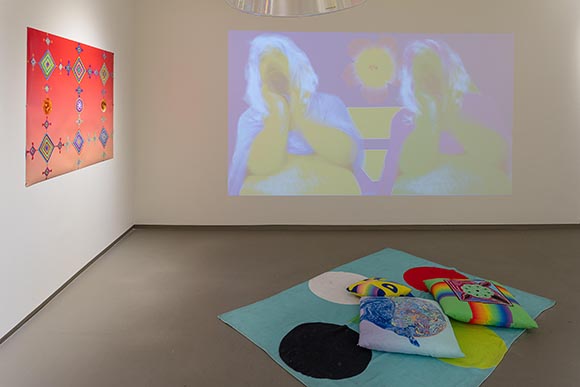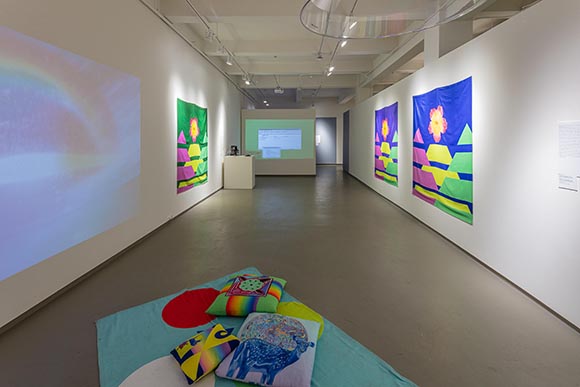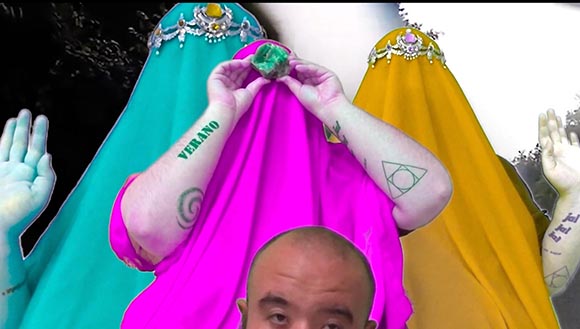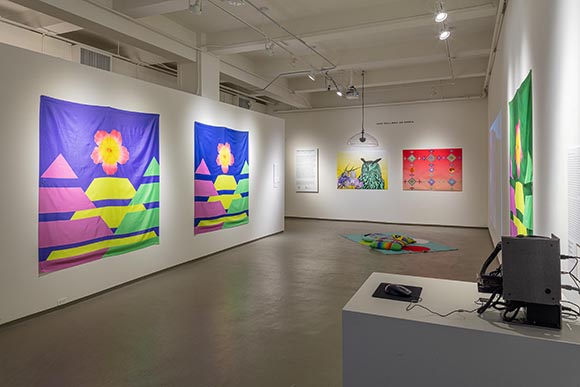Q&A WITH EDGAR FABIÁN FRÍAS
February 9, 2022
BY MOCA STAFF
Curatorial Intern Skyler Dunbar interviewed artist Edgar Fabián Frías to discuss their work in the exhibition Techno-Intimacy on view at MOCA through February 13, 2022.

Installation view, Techno-Intimacy on view August 13, 2021 – February 13, 2022 at the Museum of Contemporary Art Jacksonville, Jacksonville, FL. Photo by Doug Eng.
Q: What are some of your major sources of inspiration/influence in your work as a multidisciplinary artist?
A: I'm very inspired by my indigenous ancestors (the Wixárika). For this project, I was really thinking about ceremony and different ways that visuals are used to induce certain states of consciousness. That was one reason why I wanted to include images and textures that I felt spoke to my people. I'm also very interested in queer aesthetics, like glitch aesthetics. I'm really inspired by Legacy Russell and the ways we can work with sounds and images to mimic and push against ways that we've been taught to view video and take in media. Artists who are both co-opting and working with certain aesthetics of media while also pushing against and transforming them are very inspirational for me. And, of course, feminist artists, queer and trans artists are also a big resource for me, as are witches who are traversing different mediums and realms through their practice. It's exciting, how we translate our traditional practices into contemporary and digital spaces.
Q: How did the themes of Glitch Feminism by Legacy Russell (AFK world, digital realm as space for communities to grow and identities to develop) impact Perpetual Flowering?
A: It's been important for me to acknowledge that I'm someone who experienced difficulty figuring out how I would translate some of my metaphysical or traditional ceremonial ways of engaging into contemporary art or the digital. Legacy Russell's work has inspired me to consider the importance of translating different ways of thinking into these spaces and consider the importance of these practices existing in these spaces. I think repurposing these spaces to act as conduits for spirituality and connection was a large impetus for Perpetual Flowering- wanting to create a space for reflection, self-exploration, and intergenerational communication. Much of that has traditionally occurred in person, and I wanted to create an experience where people could receive information or knowledge through digital forms.
I also see this as a connection to the glitch because it repurposes technology. As an indigenous person, it can feel like society wants you to exist in the past and wants your art to be an ancient relic, and I have been really inspired by contemporary indigenous artists who see these digital spaces to reify our beliefs and traditions in a way that speaks to and resonates with new media. It's important- seeing these practices in a similar vein to traditional practices, and seeing our aesthetics grow and transform. So now I see Perpetual Flowering and other works that I've done as works of indigenous futurism and working with my indigenous ancestry in the present and knowing that my ancestors are speaking through me.

Installation view, Techno-Intimacy on view August 13, 2021 – February 13, 2022 at the Museum of Contemporary Art Jacksonville, Jacksonville, FL. Photo by Doug Eng.
Q: How would you describe Perpetual Flowering as an artwork or an experience?
A: I wanted to create a soundtrack that would take up and hold a space. The soundtrack I made was inspired by ceremonial practices and songs, so I re-inscribed them using techno and electronic music. I even included a hard house song because I grew up with hard house, you know, I loved the rave and techno scene, and that's also a big part of my identity. So, I feel that Perpetual Flowering speaks to the different sides of my identity: my queerness, my witchiness, my non-binariness, my indigenous ancestry. And it also connects to these practices in a way that feels invitational, because I want people to feel like they're welcomed into the space. I wanted to create an access point and create something that feels reminiscent of a domestic space while feeling a little alien, as well. I really like art that feels warm and caring but is also a bit unnerving and jarring. I think that's a place I enjoy as both an artist and art lover. I really admire works that disorient me a bit and pull me in and that's something I was hoping to achieve with this work.
Q: Perpetual Flowering has such a strong emphasis on connection, especially for members of marginalized communities, which is so important in a time that continues to isolate everyone in a literal sense and doubly isolate those the world has already deemed outcasts. Could you elaborate on the importance of connections and community in your piece, both from the focus of marginalized communities and for all viewers to experience when they enter the gallery space?
A: Art, for me, acts as a portal, as something that exists beyond time and space. I've had many experiences of connecting with an artist's intention or essence in their work and that has been profound for me. I wanted to work with that while also knowing that we've been separated. I think Legacy Russell's essay has made me think so much more about the permeability of the AFK world and that we (because of the pandemic) are living in a place where we exist simultaneously in both the physical and digital sphere. It was already there (the internet and technology) and it's only been accelerated, we have so many of our experiences online now. We should use these spaces as resources.
When I made this project initially, it was right before the pandemic began, and I was thinking of video as a resource. Now that interest has been even more augmented as people use video and livestreaming services like Zoom as ways of connecting and engaging, I think this also allows us to practice traditions that we normally wouldn't perform in person. We are now actively using the digital world as a space to connect and build community, while building tradition into that as we continue to grow. I think a lot of people have been coming to terms with that recently. When I was first making this project, I wanted it to be a sanctuary as a portal, as a space where someone can receive a download or even have a space to just be curious and rest.
The first iteration was done next to East Los Angeles College, much like how MOCA is partnered with the University of North Florida here, and I know how transformative it was for me to be an undergrad and have so many parts of myself questioned and reimagine myself in new ways through art. I wanted to create a space where people could come in, process, and integrate. So much of our time is spent overthinking and considering how we should be managing our lives, and it's important to have spaces where you can just be open, reflect, and turn to a new state of awareness.

EDGAR FABIÁN FRÍAS, Kauyumari Tatewari, duration 10’ 52”, 2019. Still from Video. Image courtesy of the artist.
Q: The themes of communal spaces in the digital world and the development of the AFK world in the future are present throughout the entire Techno-Intimacy exhibition but are particularly commanding in Perpetual Flowering. What is it that you anticipate in our digital future and our relationships to the AFK world and the expansion of spaces within? How do these thoughts impact Perpetual Flowering and your practice at large?
A: As people, we have the gift of being able to envision our future. Imagination is something that has been relegated to the arts and humanities, and I feel that imagination is something that is utilized in all aspects of life. Organizing the technological infrastructures to make the internet a possibility takes imagination, you know? At some point, someone had to imagine running cables under the ocean in the interest of connecting us all, so in an artistic and technological sense, I think imagination is a core element of our future. I'm very hopeful for our future because so many people in my communities have been focusing on bringing people's awareness back to their intuition and embodied knowledge. So much of our society has tried to distract or remove us from that, even technology has been used as a mechanism to remove us from ourselves. I'm envisioning a future where technology can be used as a resource to connect people to their intuition or even to tune out other technology.
There are ways we can work with technology that can be transgressive and go against the system, and we should think of technology in a very expansive way. There are all sorts of forms of technology, they're not all digital, though the digital presence of technology is what stays particularly present with us today. We should be elevating other forms of technology without having a hierarchy around what is more valuable.
I imagine that people in the future will also understand the technology of plants and the importance of being in fresh air. There's importance in understanding the messages of animals, and there are other networks in nature that the internet is helping us understand. I think technology is helping us move away from a regimented existence and making us want more interdependence and system-based awareness.
Q: Your work often features mentions of being a “mutant” and possessing “mutant magic”, which feels very reminiscent of Legacy Russell's term “glitch” to describe members of society who do not conform to its standards. Could you elaborate on what “mutant” means to you and how it ties into “Techno-Intimacy”?
A: “Mutant” is a part of the imaginary landscape that I work with, it's very connected to the glitch. For me, being a mutant is, in a sense, about change. I love Octavia Butler's quote about change (“All that you touch you Change. All that you Change Changes you. The only lasting truth is Change.”), and that to me is the divine spark that inspires and encourages transformation beyond the system. I think the glitch fits into that, where the system wants to run a certain way and the glitch comes to create newness or difference that can support the system or interrupt it completely.
To me, the mutant represents hope and otherness, as well as uplifting otherness. I think by reclaiming the word we connect with its power. I grew up feeling very othered, and very outside the system. Being othered has felt like a negative thing for much of my life. I think when I understood the role of medicine people among the Wixárika and recognized that there are certain people in the community that are meant to exist in but somewhat outside of the community to be a resource, that made me realize that there will always be people who will act as internal computers or intermediaries who will bring in knowledge, awareness, and encourage and support change. Those people are mutants, too, and they work with their special powers and abilities to support their community. It also informs queer and trans people that they're sacred, that we have a sacred lineage and have been placed in sacred roles for many years, and it's only due to colonialism and white supremacy that we've been told we're evil, bad, or should be ashamed of ourselves.

Installation view, Techno-Intimacy on view August 13, 2021 – February 13, 2022 at the Museum of Contemporary Art Jacksonville, Jacksonville, FL. Photo by Doug Eng.
Q: The outfits you wear in Perpetual Flowering are so unique and feel significant to the piece as a whole. What is the meaning behind these outfits, that look almost like robes in an array of colors, and what is the significance in adorning yourself in these hues?
A: I was channeling different beings for Perpetual Flowering. You could say that I'm playing different characters throughout the video. In the beginning video I'm playing Takutsinakawe, a goddess of water and the ocean- a bringer of life, death, and transformation. I wore a turquoise gown that reminded me of the water and paired it with a turquoise and pink wig as a way to embody that being and channel her energy. Later, I take on the role of a Marakame, a medicine person of the Wixárika, so I also wished to embody this role of a link, a person who can traverse the sacred, and I wished to represent myself both as a member of the sacred and one who communicates with the sacred.
I'm very playful when it comes to my outfits and very simple because I'm learning how to make clothing, it's not something I'm trained in. I allow myself to move into mediums I don't feel comfortable in.
Q: Perpetual Flowering also plays with this relationship between activism and healing. Could you elaborate on the significance of these two points and why they're a central focus of Perpetual Flowering?
A: I see them as interdependent. It's a hard thing to navigate because we need spaces for respite where we can experience self-care and process. And many of us need healing from the systems that we're a part of, and I feel that art is a medium that allows a person to work on things simultaneously. I'm someone who has worked in all mediums, including community organizing and social practice. I'm also a therapist, so I've worked on healing individuals and groups, too. I see my art as a space where I can do all of this at once and still can envision another life for myself. That's the power I find in art. It can be a vehicle for reorganizing and re-envisioning what is possible in your life. The Wixárika don't separate art and activism or healing and activism, it's all interwoven together. A lot of protests have these beautiful rituals, art, and prayers connected to them. And many of us find deep meaning and value in the activism that we do because it keeps us going and keeps us feeling like we have a purpose. And that's so deeply connected to our health, too, that I see them as interconnected.
Q: Ultimately, what do you hope viewers take away from Perpetual Flowering?
A: I don't want to dictate what people experience. I want the work to do its work on people. I understand that people will be coming into the space with many different things that they're holding within themselves, so I do hope that it can offer a space where they can put those things aside for a second. I'm open to what that moment does for them, what impact that has. I hope that it will offer a moment of reflection, but also spark a sense of newness and curiosity. The chance to offer that is exciting for me. And, to see a person that traditionally wasn't elevated, or hasn't been elevated in these spaces become uplifted is so important and new. This is the first video piece where I show my body without clothing on, and that vulnerability felt very important because I'm sharing something new. And it's important to see people that look like you or see people you're confused by or don't understand. That's an important thing to encounter in representation in artistic spaces.
I'm grateful for this time and opportunity to explain my process. I hope that this iteration, especially in connection to all the other incredible artworks in Techno-Intimacy, helps people see the possibility in technology and expand how they feel they can show up in this space. I want people to feel invited to redefine what intimacy looks like for them, and how they interact and connect with technology. I hope people reconsider what technology is because “technology” really is such an expansive word.
